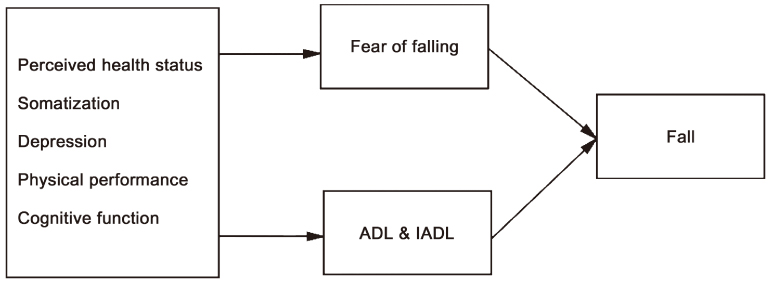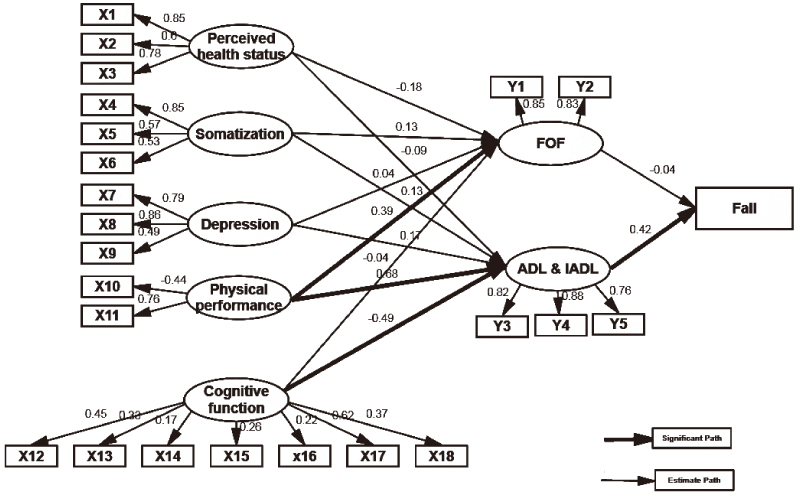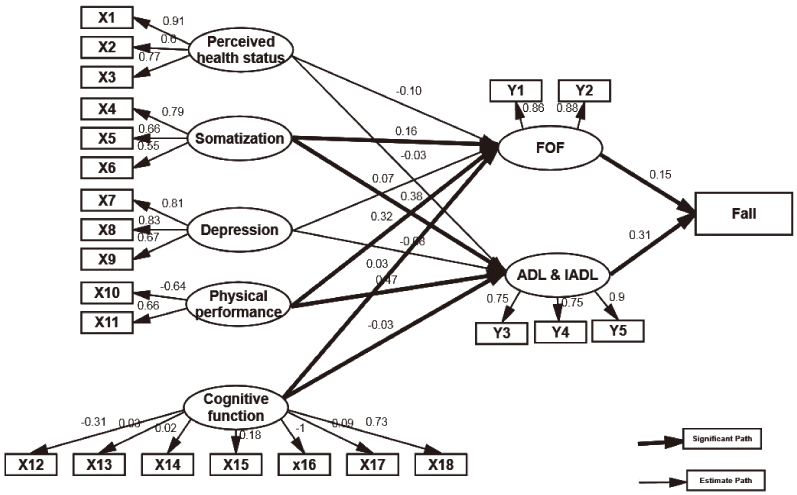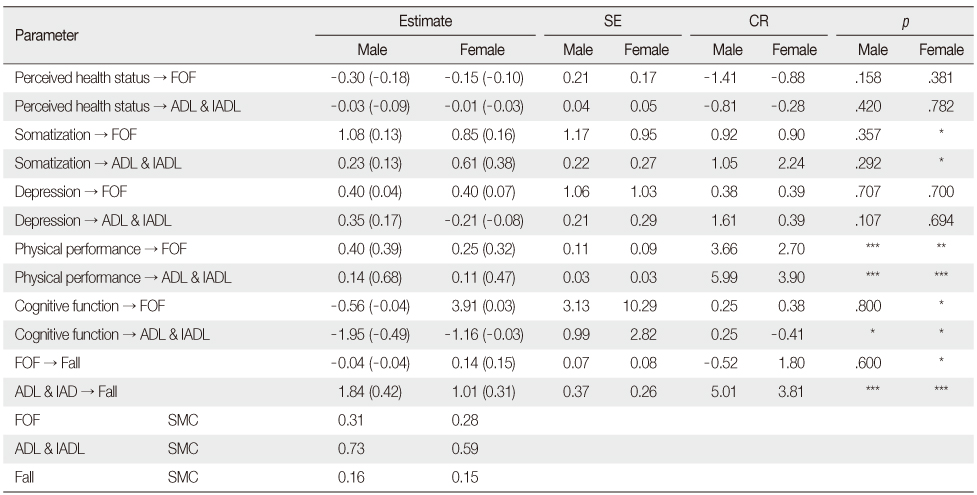Articles
- Page Path
- HOME > J Korean Acad Nurs > Volume 42(6); 2012 > Article
-
Original Article
- Fall Prediction Model for Community-dwelling Elders based on Gender
- Eun Suk Yun
-
Journal of Korean Academy of Nursing 2012;42(6):810-818.
DOI: https://doi.org/10.4040/jkan.2012.42.6.810
Published online: December 31, 2012
Ewha Womans University, Seoul, Korea.
- Address reprint requests to: Yun, Eun Suk. Ewha Womans University, 52, Ewhayeodae-gil, Seodaemun-gu, Seoul 120-750, Korea. Tel: +82-2-3277-2114, Fax: +82-2-393-5903, yes100406@naver.com
© 2012 Korean Society of Nursing Science
- 705 Views
- 2 Download
- 12 Crossref
Abstract
-
Purpose
- This study was done to explore factors relating to number of falls among community-dwelling elders, based on gender.
-
Methods
- Participants were 403 older community dwellers (male=206, female=197) aged 60 or above. In this study, 8 variables were identified as predictive factors that can result in an elderly person falling and as such, supports previous studies. The 8 variables were categorized as, exogenous variables; perceived health status, somatization, depression, physical performance, and cognitive state, and endogenous variables; fear of falling, ADL & IADL and frequency of falls.
-
Results
- For men, ability to perform ADL & IADL (β32=1.84, p<.001) accounted for 16% of the variance in the number of falls. For women, fear of falling (β31=0.14, p<.05) and ability to perform ADL & IADL (β32=1.01, p<.001) significantly contributed to the number of falls, accounting for 15% of the variance in the number of falls.
-
Conclusion
- The findings from this study confirm the gender-based fall prediction model as comprehensive in relation to community-dwelling elders. The fall prediction model can effectively contribute to future studies in developing fall prediction and intervention programs.
- 1. Andresen EM, Wolinsky FD, Miller JP, Wilson MM, Malmstrom TK, Miller DK. Cross-sectional and longitudinal risk factors for falls, fear of falling, and falls efficacy in a cohort of middle-aged African Americans. Gerontologist. 2006;46:249–257. http://dx.doi.org/10.1093/geront/46.2.249.ArticlePubMedPDF
- 2. Bae B. Structural equation modeling with Amos 17.0 -Principles and practice-. 2009;Seoul, Chung Ram Books.
- 3. Choi K, Park U, Lee I. Factors influencing the fear of falling according to gender in frail elderly. J Korean Gerontol Soc. 2011;31:539–551.
- 4. Ding L, Velicer WF, Harlow LL. Effects of estimation methods, number of indicators per factor, and improper solutions on structural equation modeling fit indices. Struct Equ Modeling. 1995;2:119–143. http://dx.doi.org/10.1080/10705519509540000.Article
- 5. Folstein MF, Folstein SE, McHugh PR. "Mini-Mental-State": A practical method for grading the cognitive state of patients for the clinician. J Psychiatr Res. 1975;12:189–198. http://dx.doi.org/10.1016/0022-3956(75)90026-6.PubMed
- 6. Gassmann KG, Rupprecht R, Freiberger E. Predictors for occasional and recurrent falls in community-dwelling older people. Z Gerontol Geriatr. 2009;42:3–10. http://dx.doi.org/10.1007/s00391-008-0506-2.ArticlePubMedPDF
- 7. Hwang MH. A model of self-care and well being of elderly. 2000;Daegu, Kyungpook National University. Unpublished doctoral dissertation.
- 8. Kang Y, Na DL, Hahn S. A validity study on the Korean Mini-Mental State Examination (K-MMSE) in dementia patients. J Korean Neurol Assoc. 1997;15:300–308.
- 9. Katz S, Ford AB, Moskowitz RW, Jackson BA, Jaffe MW. Studies of illness in the aged. The index of ADL: A standardized measure of biological and psychosocial function. JAMA. 1963;185:914–919. http://dx.doi.org/10.1001/jama.1963.03060120024016.ArticlePubMed
- 10. Kee BS. A preliminary study for the standardization of geriatric depression scale short form - Korea version. J Korean Neuropsychiatr Assoc. 1996;35:298–307.
- 11. Kempen GI, van Haastregt JC, McKee KJ, Delbaere K, Zijlstra GA. Socio-demographic, health-related and psychosocial correlates of fear of falling and avoidance of activity in community-living older persons who avoid activity due to fear of falling. BMC Public Health. 2009;9:170. http://dx.doi.org/10.1186/1471-2458-9-170.PubMedPMC
- 12. Kim JM. An analysis of falls in the elderly: A PRECEDE model approach. 2008;Seoul, Ewha Womans University. Unpublished doctoral dissertation.
- 13. Kim S, Chun Y. The effect of level of physical strength, depression, and daily lives on falling of the elders using senior center. J Sport Leis Stud. 2010;39:755–762.Article
- 14. Kim TG. A study of fear of falling and IADL in an urban and a rural population. 2010;Seoul, Hanyang University. Unpublished doctoral dissertation.
- 15. Korea National Statistical Office. Statistical report on the aged 2011. 2011;Retrieved September 29, 2011. from http://kostat.go.kr/portal/korea/kor_nw/2/1/index.board?bmode=read&aSeq=250718.
- 16. Kroenke K, Spitzer RL, Williams JB. The PHQ-15: Validity of a new measure for evaluating the severity of somatic symptoms. Psychosom Med. 2002;64:258–266.ArticlePubMed
- 17. Lawton MP, Brody EM. Assessment of older people: Self maintaining and instrumental activities of daily living. Gerontologist. 1969;9:179–186. http://dx.doi.org/10.1093/geront/9.3_Part_1.179.ArticlePubMed
- 18. Lee KJ, Park HS. A study on the perceived health status, depression, and activities of daily living for the elderly in urban areas. Korean J Women Health Nurs. 2006;12:221–230.ArticlePDF
- 19. Lee YH, Lee KJ, Han GS, Yoon SJ, Lee YK, Kim CH, et al. The development of physical functioning scale for community-dwelling older persons. Korean J Prev Med. 2002;35:359–374.
- 20. Mathias S, Nayak US, Issacs B. Balance in elderly patients: The "Get-up and Go" test. Arch Phys Med Rehabil. 1986;67:387–389.PubMed
- 21. Park JW, Yoo H. Fear of falling, ADL and physical functioning among senior citizens. Korean J Rehabil Nurs. 2006;9:117–125.
- 22. Rubenstein LZ, Josephson KR. Falls and their prevention in elderly people: What does the evidence show? Med Clin North Am. 2006;90:807–824. http://dx.doi.org/10.1016/j.mcna.2006.05.013.ArticlePubMed
- 23. Scheffer AC, Schuurmans MJ, van Dijk N, van der Hooft T, de Rooij SE. Fear of falling: Measurement strategy, prevalence, risk factors, and consequences among older persons. Age Ageing. 2008;37:19–24. http://dx.doi.org/10.1093/ageing/afm169.ArticlePubMed
- 24. Sheikh JI, Yesavage JA. Geriatric depression scale (GDS): Recent evidence and development of a shorter version. Clin Gerontol. 1986;5:165–173. http://dx.doi.org/10.1300/J018v05n01_09.
- 25. Speake DL, Cowart ME, Pellet K. Health perceptions and lifestyles of the elderly. Res Nurs Health. 1989;12:93–100. http://dx.doi.org/10.1002/nur.4770120206.ArticlePubMed
- 26. Spitzer RL, Kroenke K, Williams JB. Validation and utility of a self-report version of PRIME-MD. JAMA. 1999;282:1737–1744. http://dx.doi.org/10.1001/jama.282.18.1737.ArticlePubMed
- 27. Steiger JH. Structural model evaluation and modification: An interval estimation approach. Multivariate Behav Res. 1990;25:173–180. http://dx.doi.org/10.1207/s15327906mbr2502_4.ArticlePubMed
- 28. Yoo IY. Effects of fall prevention program applying HSEP on physical balance and gait, leg strength, fear of falling and falls efficacy of community-dwelling elderly. J Korean Gerontol Soc. 2009;29:259–273.
- 29. Yoo IY. Analysis of multi-variate recurrent fall risk factors in elderly people using residential assessment instrument-home carecomparisons between single and recurrent fallers. J Korean Acad Nurs. 2011;41:119–128. http://dx.doi.org/10.4040/jkan.2011.41.1.119.ArticlePubMed
- 30. Zijlstra GA, van Haastregt JC, van Eijk JTh, van Rossum E, Stalenhoef PA, Kempen GI. Prevalence and correlates of fear of falling, and associated avoidance of activity in the general population of community-living older people. Age Ageing. 2007;36:304–309. http://dx.doi.org/10.1093/ageing/afm021.ArticlePubMed
REFERENCES
Figure & Data
REFERENCES
Citations

- Development of a fall prediction model for community-dwelling older adults in South Korea using machine learning: a secondary data analysis
Minhee Suh, Hyesil Jung, Juli Kim
Journal of Korean Biological Nursing Science.2024; 26(4): 288. CrossRef - Risk Factors for Falls or Fractures in Stroke Patients: An Analysis of 2020 Patient Sample Data
Miso Lee, Mikyung Moon
The Korean Journal of Rehabilitation Nursing.2024; 27(1): 58. CrossRef - Fear of falling and related factors during everyday activities in patients with chronic stroke
Suna Park, Ok-Hee Cho
Applied Nursing Research.2021; 62: 151492. CrossRef - Association between Falls and Nutritional Status of Community-Dwelling Elderly People in Korea
Ah-Ra Jo, Mi-Jeong Park, Byung-Gue Lee, Young-Gyun Seo, Hong-Ji Song, Yu-Jin Paek, Kyung-Hee Park, Hye-Mi Noh
Korean Journal of Family Medicine.2020; 41(2): 111. CrossRef - The Physical Activity and Fall Risk Among Iranian Older Male Adults
Mehdi Kushkestani, Mohsen Parvani, Shiva Ebrahimpour Nosrani, Sohrab Rezaei
The Open Nursing Journal.2020; 14(1): 159. CrossRef - Predictors of Accidental Falls in the Community-dwelling Elderly by Age
Nan Ju Park, Yong Soon Shin
Journal of Korean Academy of Community Health Nursing.2019; 30(2): 141. CrossRef - Tool for Categorizing Remaining Functional Ability of Nursing Home Residents
Hyun Ju Kim, Sung Ok Chang
Journal of Korean Gerontological Nursing.2019; 21(1): 1. CrossRef - Relationships between falls, age, independence, balance, physical activity, and upper limb function in elderly Brazilians
Daniel Marinho Cezar da Cruz, Tatiane de Carvalho Lima, Lauren Jane Nock, Mirela de Oliveira Figueiredo, Debora Caires Paulisso, Albert Lee
Cogent Medicine.2017; 4(1): 1367058. CrossRef - Effects of a Randomized Controlled Recurrent Fall Prevention Program on Risk Factors for Falls in Frail Elderly Living at Home in Rural Communities
JongEun Yim
Medical Science Monitor.2014; 20: 2283. CrossRef - Comparisons of the Falls and Intrinsic Fall Risk Factors according to Gender in the elderly at Ttransitional Periods of Life
Eunshil Yim, Dosuk Kim, Bohwan Kim
The Journal of the Korea Contents Association.2013; 13(12): 276. CrossRef - Risk Factors for Recurrent Falls Among Community-dwelling Elderly in Rural Areas
Mi-Yang Jeon, Sun Hee Yang
Journal of the Korea Academia-Industrial cooperation Society.2013; 14(12): 6353. CrossRef - Safety Consciousness of the Elderly Living Alone
Youngsil Kang, Sun Jae Jung
Journal of muscle and joint health.2013; 20(3): 180. CrossRef



Figure 1
Figure 2
Figure 3
Correlation Matrix among Measured Variables
ADL & IADL=Activities of daily living and instrumental activities of daily living.
*p<.05; **p<.01.
Estimates and Effects of Predictor Variables in Modified Model
FOF=Fear of falling; ADL & IADL=Activities of daily living and instrumental activities of daily living; SE=Standard error; CR=Critical ratio;
SMC=Squared multiple correlation.
Regression weight (Standardized regression weight).
*p<.05; **p<.01; ***p<.001.
ADL & IADL=Activities of daily living and instrumental activities of daily living. *
FOF=Fear of falling; ADL & IADL=Activities of daily living and instrumental activities of daily living; SE=Standard error; CR=Critical ratio; SMC=Squared multiple correlation. Regression weight (Standardized regression weight). *
 KSNS
KSNS
 E-SUBMISSION
E-SUBMISSION





 Cite
Cite

